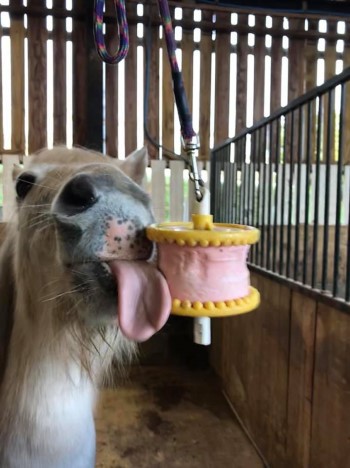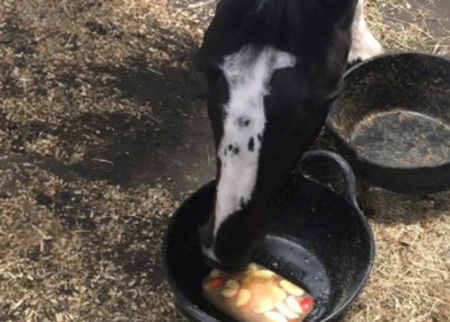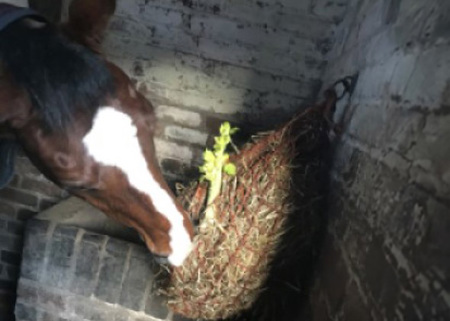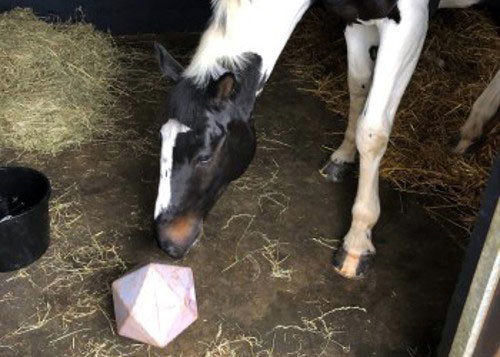In cases where stabling is necessary, utilising your horse’s natural foraging behaviours to provide enrichment is crucial1. Horse owners and carers can consider a variety of enrichment options to keep their horses happy and healthy in the stable2.
It's important to note that individual horses may respond differently to these methods, and what works well for one horse might not be suitable for another.
Read about Sophie and Chuck’s experience of box rest after a serious injury, where they explored different ways to enrich his environment.
If this is your first time exploring enrichment options for your horse, make sure you read through our enrichment guide which advises on how to introduce these safely.
If competing, check your governing body's rules regarding Clean Sport, for example, specific food and herbs that may be prohibited.
Edible enrichment
Horses have evolved to graze for up to 18 hours a day. This keeps their minds active and provides a regular supply of forage to their gut, which is crucial for their health and wellbeing. When stabled, you can use a variety of methods to provide your horse’s forage. Toys and activities can also be introduced to help provide mental stimulation. These should be introduced slowly and with care to make sure your horse finds them engaging and pleasurable, and that they don’t cause frustration or potential injury.
Fruit and vegetable kebabs
chevron-down
chevron-up
Carefully put a hole through a variety of fruit and vegetables such as carrots, apples, parsnips, turnips, swede, sprouts, watermelon and banana and string them up into fruit kebabs. Use a piece of baler twine or thin rope to hang up vertically in the stable. Make sure you don’t leave a loop that the horses could get stuck on or injure themselves. Fruit kebabs should only be offered under supervision and to horses with good teeth to prevent the risk of choke.
Where possible fruits and vegetables should be sliced lengthways and fed in moderation. For horses with poor teeth or who may struggle with hanging kebabs, you can hide strips of vegetables around the stable or in their forage for them to find. It’s extremely important to introduce new foods, such as different fruits and vegetables, gradually over a period of 10-14 days to reduce the risk of colic.
When introducing new enrichment always supervise your horse, and if you have any concerns, remove it.
Horse licks
chevron-down
chevron-up
There are numerous types of different horse licks available such as mineral, salt and flavoured licks. These can either be hung up in the stable or put in as a tub. Be careful as some are high in sugar and horses have been known to devour a whole tub in one night, so these may need to be used in moderation and under supervision!

On warmer days, cut up your horse’s favourite fruit and veg. Pour on some water and freeze to make a tasty fruit ice block. You can also mix some fruit juice with the water for an extra sweet treat. Just consider how much sugar you’re adding into their diet, especially for horses prone to laminitis.

Different types of fibre
chevron-down
chevron-up
Another option is adding good-quality straw to your horse’s hay/haylage4.
- You can add up to half of your horse’s forage ration with straw, though it’s important to start at a small amount and build this up gradually over at least 10-14 days to avoid colic.
- Straw is a low-calorie option compared to hay/haylage, so horses can have more fibre to eat without the added calories.
- Straw can keep your horse more occupied as it takes longer to chew and slows down digestion, which means your horse will feel full for a longer period.
- Mixing straw and hay encourages horses to search and pick out the hay first, which is a good activity for them and even if they don’t eat the straw, it will make the hay last longer.
- Chewing naturally makes horses feel good because it increases serotonin, also known as the 'happy' hormone. By eating straw, horses can spend more time chewing, which can improve their mood.
Introducing a selection of fibre sources around the stable using different buckets (in addition to hay/haylage) provides variety and allows your horse the opportunity to browse between the options3. Contact a qualified nutritionist, either through a feed company or independent, who can help you formulate an individual feed plan for your horse.
It’s important to regularly fat score (also known as body condition scoring) your horse if they’re restricted to their stable for prolonged periods, such as box rest. Horses can be prone to weight loss or gain, and early recognition of this can prevent further complications.
Different types of fibre include:
- Short chop chaffs
- Fibre mixes
- Fibre cubes.
You can also add alternative fibre sources within their hay/haylage, such as:
- Strips of fruit and vegetables
- Fibre nuts
- Horse-safe hedgerow plants (cow parsley, cleavers and other herbs)
- When picking from the hedgerows, make sure you’re aware of and avoid poisonous plants.

Stable toys and feeders
chevron-down
chevron-up
Ball feeders and hanging toys can help to provide mental stimulation and be a more interesting way of feeding. Your horse works for the food which helps to slow down the rate of consumption, for example, feeding fibre nuts or other pellet feed in a ball feeder compared to a feed bowl. Introduce gradually by placing some food on the floor next to the feeder. This should help encourage your horse to investigate and move the ball. If not, you may need to scatter food over a small area and move the ball, so your horse starts to understand that moving the ball results in a food reward. This also provides some additional movement for the horse.

Hay and haylage feeding methods
Hay and haylage can be fed to the horse using a variety of methods. There are advantages and disadvantages to each different method, so it’s important to consider all factors before making a choice on what would be most suitable for your horse.
Feeding from the floor
chevron-down
chevron-up
One top tip when feeding from the floor is to put piles of food in different areas so your horse isn’t stood in the same spot. It’s also useful to use large plastic tubs to prevent waste.
This method:
- Is a natural eating position for your horse
- Is good for horses who are fed ad lib
- Can cause wastage if dragged into dirty areas of the stable
- Horses on a restricted diet may finish their ration quickly and mean they’re without forage for a longer time.
Alternative options
chevron-down
chevron-up
There are many products available on the market to help slow down the rate of consumption of forage, these include various hay balls and slow feeders. These products can be particularly beneficial for horses who gain weight easily as it makes their ration last longer while occupying their mind and providing mental stimulation similar to that experienced by grazing and foraging5.

If using small holed haynets, it’s recommended to slowly introduce their use by decreasing the hole size gradually or packing the net lightly to start with. Horses have an inherent need to express feeding behaviour, so a small amount of hay given on the floor to eat first may prevent some frustration when they’re hungry.
This method:
- Increases feeding time compared to feeding from the floor, especially using small holed haynets
- Can encourage movement if haynets are hung up in different areas of your horse’s stable
- Isn’t recommended for horses with neck and/or back problems as it can place their head in an unnatural eating position.
Non-edible enrichment
Grooming
chevron-down
chevron-up
Mutual grooming is one of the most common social activities for horses. The wither area is often a preferred spot. By taking the time to give your horse a good groom it helps:
- Improve the human – horse bond
- Lower your horse’s heart rate
- Increase blood flow to the skin’s surface
- Promote a healthy coat
- Massage large muscle groups
- Provide an opportunity to check for any lumps and bumps
- Incorporate some gentle stretch exercises such as gently lifting a front leg forward.

Music
chevron-down
chevron-up
Try playing some different types of music, for short periods, to see what helps your horse to relax. Research has shown that classical and country music is preferred by most horses, reducing displays of stress and improving their sleeping and eating habits6.
It’s important to avoid loud volumes and long periods of playing music as this may cause your horse stress. Remember to consider the reactions of nearby horses, who may not enjoy the music as much as your own horse.
Horses naturally use their hearing to locate their friends and potential dangers. Noises like moving tack, opening of feed bins or vehicles approaching give them information so they can predict upcoming activities. Keeping your horse’s environment peaceful, without sudden, loud noises will help them to relax in the stable.
Mirrors
chevron-down
chevron-up
Research has found that use of stable mirrors can:
- Reduce the incidence of stereotypical behaviour7
- Benefit horses suffering from separation anxiety as they can see another horse.
Here’s some tips on using mirrors safely:
- Many horses are naturally cautious when they first see their reflection. It can take a couple of weeks to accept and benefit from the mirror.
- Introduce the mirror to your horse outside of their stable so they have space to move away if they don’t like it.
- Always use safe materials such as acrylic plastic.
- Make sure the mirror is positioned so your horse has a choice to look at their reflection or not.
- Be wary of installing mirrors along the whole length of a wall, or close to your horse’s eating area as this can cause more stress and anxiety or aggression and protectiveness of their food.
- If you find your horse responds with constant aggression, we recommend you remove the mirror.
Windows
chevron-down
chevron-up
Giving your horse the ability to see more around them, especially other horses, can provide more interest for them, particularly if they’re stabled during the day. More visual access allows horses to engage in a wider variety of activities, which may distract them from stereotypic behaviours (eg weaving and crib biting), by allowing them to monitor their surroundings and interact socially8.
If your horse is required to be on box rest, it can be beneficial to keep another horse in while the others are turned out. This can be done on a rota basis so the other horses aren’t restricted too much. You can also move your horse to a different stable during the day, if safe to do so. This will provide some enrichment by offering different views and smells for them to explore.
References
- Brolin, S. (2022). The Importance of Natural Feeding Behaviour for Horse (Equus caballus) Welfare.
- Lansade, L., et al (2014). Behavioral and transcriptomic fingerprints of an enriched environment in horses (Equus caballus). PloS one, 9(12), e114384.
- Thorne et al., (2005).Foraging enrichment for individually housed horses: Practicality and effects on behaviour - ScienceDirect
- Webinar -
Straw: the answer to horse obesity? Nadine Mostert and Briony Witherow - AskAnimalweb (drdavidmarlin.com)
- Rochais, C., et al. (2018). “Hay-bags” and “Slow feeders”: Testing their impact on horse behaviour and welfare. Applied Animal Behaviour Science, 198, 52-59
- Greening, L. et al. (2013). Auditory stimulation of the stabled equine; the effect of different music genres on behaviour. ResearchGate.
- McAfee, L. et al. (2002). The use of mirrors for the control of stereotypic weaving behaviour in the stabled horse. Applied Animal Behaviour Science. 78 (2-4) pages 159-173.
Get in touch – we’re here to help
The Horse Care and Welfare Team are here to help and can offer you further advice with any questions you may have. Contact us on 02476 840517* or email welfare@bhs.org.uk – You can also get in touch with us via our social media channels.
Opening times are 8:35am-5pm from Monday–Thursday and 8:35am-3pm on Friday.
*Calls may be recorded for monitoring purposes.


